University of Greenwich: Health, Safety and Environmental Plans Report
VerifiedAdded on 2023/05/29
|46
|11224
|205
Report
AI Summary
This report examines the health, safety, and environmental (HSE) plans within the oil production industry, with a specific focus on Royal Dutch Shell's operations between 2006 and 2015. The study investigates the impact of oil and gas activities on the environment and the safety of workers. It includes an introduction outlining the background, problem statement, aims, objectives, and research questions. A literature review explores environmental impacts, workplace safety models, risk management, and relevant practices. The research methodology outlines the research philosophy, approach, design, data collection, and analysis methods. The data analysis and findings chapter presents qualitative analysis, while the conclusion and recommendations chapter summarizes the study's findings, offers recommendations for improvement, and acknowledges limitations. The report aims to evaluate the effectiveness of Shell's HSE policies, identify major health and safety issues, and suggest improvements for a safer and more sustainable oil production process. The research also highlights the importance of sustainable development in the oil and gas industry, addressing issues such as pollution, corruption, and civil disturbances.
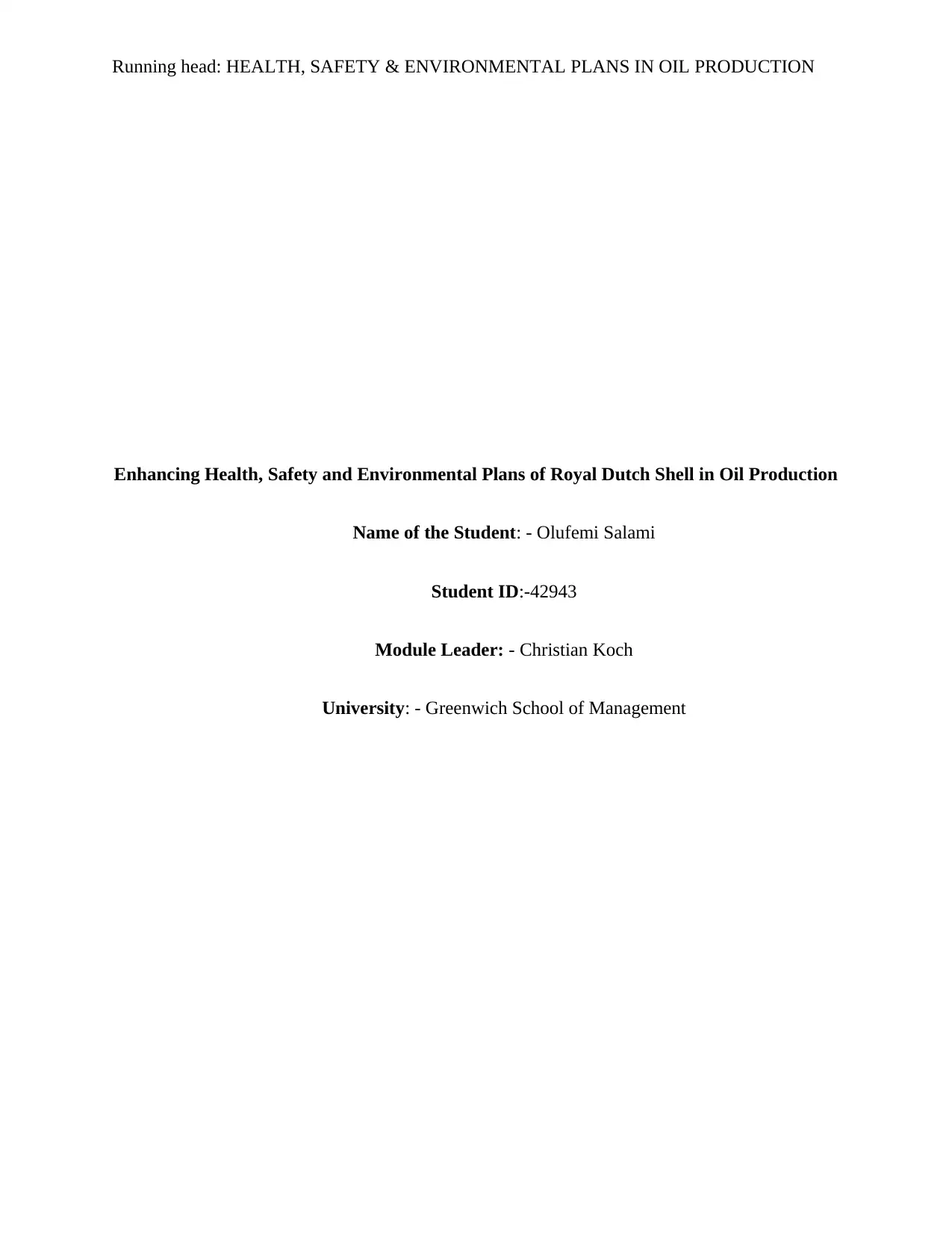
Running head: HEALTH, SAFETY & ENVIRONMENTAL PLANS IN OIL PRODUCTION
Enhancing Health, Safety and Environmental Plans of Royal Dutch Shell in Oil Production
Name of the Student: - Olufemi Salami
Student ID:-42943
Module Leader: - Christian Koch
University: - Greenwich School of Management
Enhancing Health, Safety and Environmental Plans of Royal Dutch Shell in Oil Production
Name of the Student: - Olufemi Salami
Student ID:-42943
Module Leader: - Christian Koch
University: - Greenwich School of Management
Paraphrase This Document
Need a fresh take? Get an instant paraphrase of this document with our AI Paraphraser
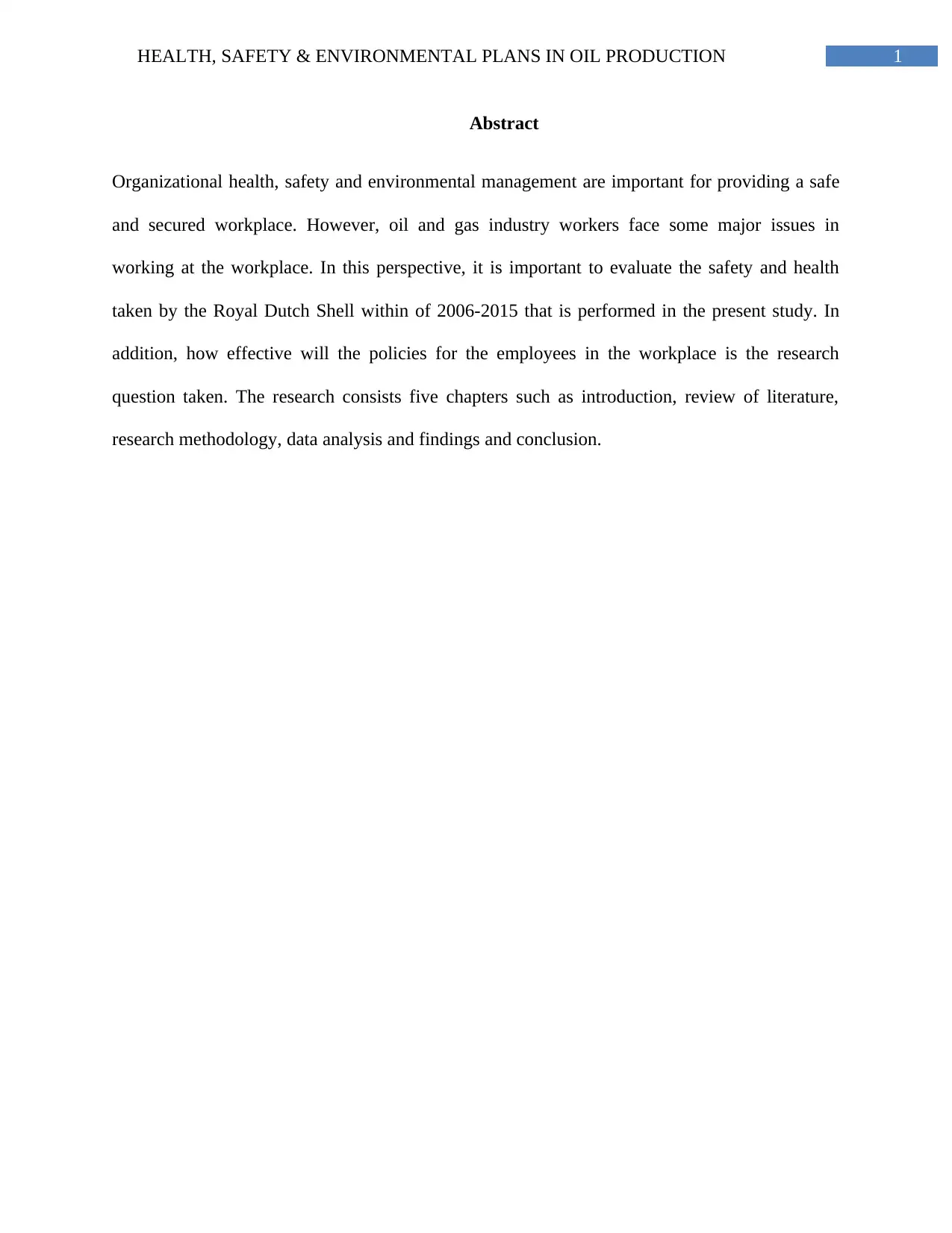
1HEALTH, SAFETY & ENVIRONMENTAL PLANS IN OIL PRODUCTION
Abstract
Organizational health, safety and environmental management are important for providing a safe
and secured workplace. However, oil and gas industry workers face some major issues in
working at the workplace. In this perspective, it is important to evaluate the safety and health
taken by the Royal Dutch Shell within of 2006-2015 that is performed in the present study. In
addition, how effective will the policies for the employees in the workplace is the research
question taken. The research consists five chapters such as introduction, review of literature,
research methodology, data analysis and findings and conclusion.
Abstract
Organizational health, safety and environmental management are important for providing a safe
and secured workplace. However, oil and gas industry workers face some major issues in
working at the workplace. In this perspective, it is important to evaluate the safety and health
taken by the Royal Dutch Shell within of 2006-2015 that is performed in the present study. In
addition, how effective will the policies for the employees in the workplace is the research
question taken. The research consists five chapters such as introduction, review of literature,
research methodology, data analysis and findings and conclusion.
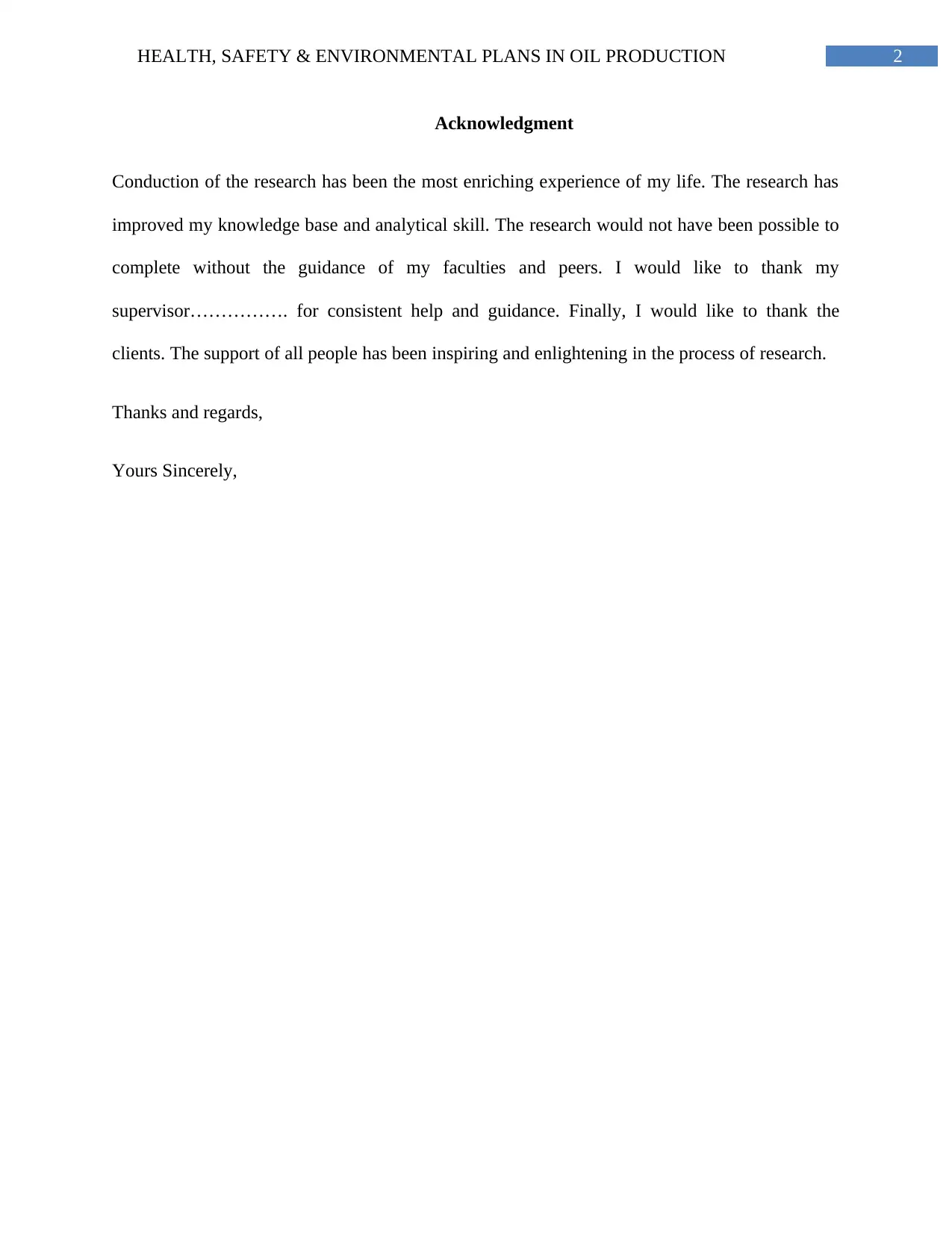
2HEALTH, SAFETY & ENVIRONMENTAL PLANS IN OIL PRODUCTION
Acknowledgment
Conduction of the research has been the most enriching experience of my life. The research has
improved my knowledge base and analytical skill. The research would not have been possible to
complete without the guidance of my faculties and peers. I would like to thank my
supervisor……………. for consistent help and guidance. Finally, I would like to thank the
clients. The support of all people has been inspiring and enlightening in the process of research.
Thanks and regards,
Yours Sincerely,
Acknowledgment
Conduction of the research has been the most enriching experience of my life. The research has
improved my knowledge base and analytical skill. The research would not have been possible to
complete without the guidance of my faculties and peers. I would like to thank my
supervisor……………. for consistent help and guidance. Finally, I would like to thank the
clients. The support of all people has been inspiring and enlightening in the process of research.
Thanks and regards,
Yours Sincerely,
⊘ This is a preview!⊘
Do you want full access?
Subscribe today to unlock all pages.

Trusted by 1+ million students worldwide
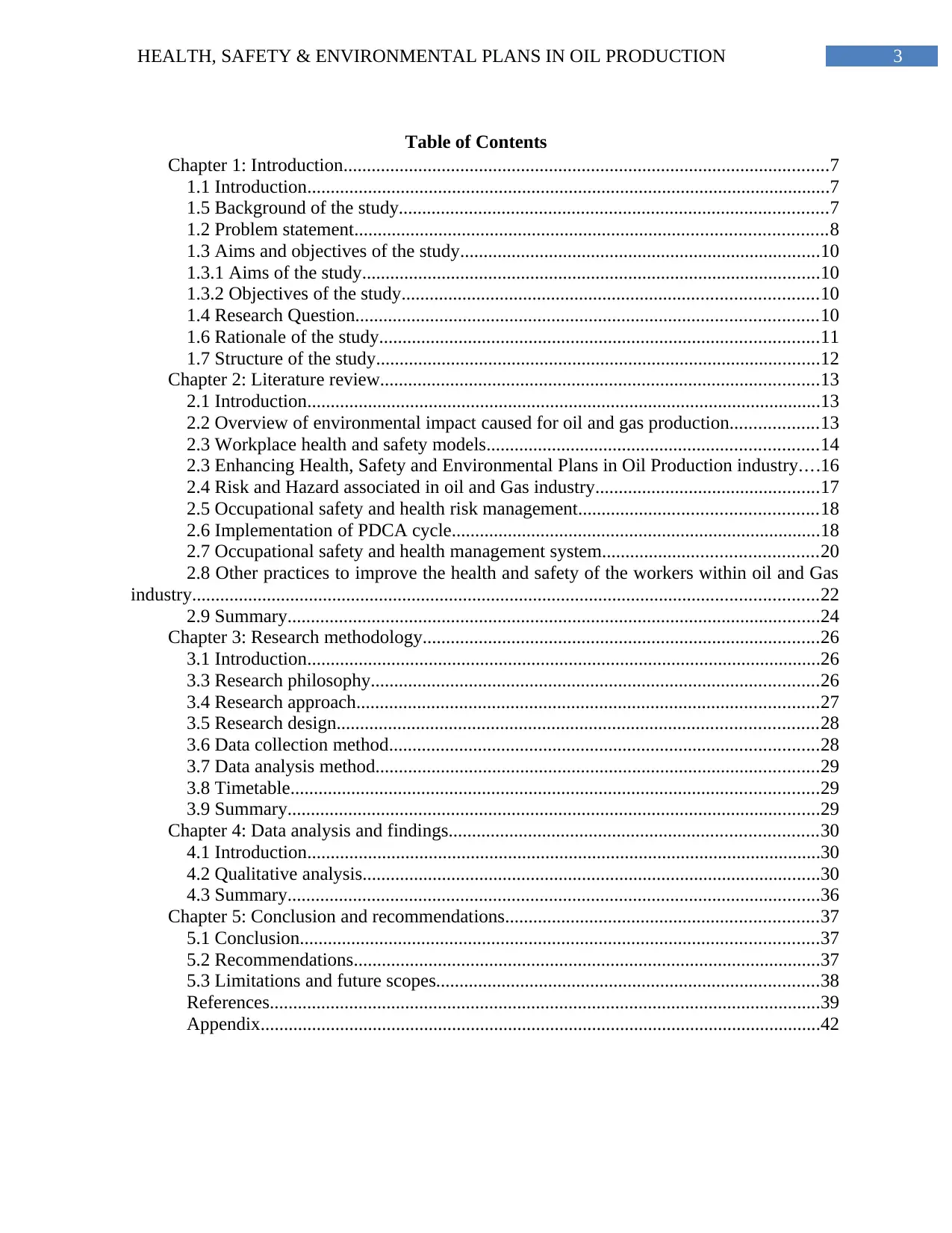
3HEALTH, SAFETY & ENVIRONMENTAL PLANS IN OIL PRODUCTION
Table of Contents
Chapter 1: Introduction........................................................................................................7
1.1 Introduction................................................................................................................7
1.5 Background of the study............................................................................................7
1.2 Problem statement.....................................................................................................8
1.3 Aims and objectives of the study.............................................................................10
1.3.1 Aims of the study..................................................................................................10
1.3.2 Objectives of the study.........................................................................................10
1.4 Research Question...................................................................................................10
1.6 Rationale of the study..............................................................................................11
1.7 Structure of the study...............................................................................................12
Chapter 2: Literature review..............................................................................................13
2.1 Introduction..............................................................................................................13
2.2 Overview of environmental impact caused for oil and gas production...................13
2.3 Workplace health and safety models.......................................................................14
2.3 Enhancing Health, Safety and Environmental Plans in Oil Production industry....16
2.4 Risk and Hazard associated in oil and Gas industry................................................17
2.5 Occupational safety and health risk management...................................................18
2.6 Implementation of PDCA cycle...............................................................................18
2.7 Occupational safety and health management system..............................................20
2.8 Other practices to improve the health and safety of the workers within oil and Gas
industry......................................................................................................................................22
2.9 Summary..................................................................................................................24
Chapter 3: Research methodology.....................................................................................26
3.1 Introduction..............................................................................................................26
3.3 Research philosophy................................................................................................26
3.4 Research approach...................................................................................................27
3.5 Research design.......................................................................................................28
3.6 Data collection method............................................................................................28
3.7 Data analysis method...............................................................................................29
3.8 Timetable.................................................................................................................29
3.9 Summary..................................................................................................................29
Chapter 4: Data analysis and findings...............................................................................30
4.1 Introduction..............................................................................................................30
4.2 Qualitative analysis..................................................................................................30
4.3 Summary..................................................................................................................36
Chapter 5: Conclusion and recommendations...................................................................37
5.1 Conclusion...............................................................................................................37
5.2 Recommendations....................................................................................................37
5.3 Limitations and future scopes..................................................................................38
References......................................................................................................................39
Appendix........................................................................................................................42
Table of Contents
Chapter 1: Introduction........................................................................................................7
1.1 Introduction................................................................................................................7
1.5 Background of the study............................................................................................7
1.2 Problem statement.....................................................................................................8
1.3 Aims and objectives of the study.............................................................................10
1.3.1 Aims of the study..................................................................................................10
1.3.2 Objectives of the study.........................................................................................10
1.4 Research Question...................................................................................................10
1.6 Rationale of the study..............................................................................................11
1.7 Structure of the study...............................................................................................12
Chapter 2: Literature review..............................................................................................13
2.1 Introduction..............................................................................................................13
2.2 Overview of environmental impact caused for oil and gas production...................13
2.3 Workplace health and safety models.......................................................................14
2.3 Enhancing Health, Safety and Environmental Plans in Oil Production industry....16
2.4 Risk and Hazard associated in oil and Gas industry................................................17
2.5 Occupational safety and health risk management...................................................18
2.6 Implementation of PDCA cycle...............................................................................18
2.7 Occupational safety and health management system..............................................20
2.8 Other practices to improve the health and safety of the workers within oil and Gas
industry......................................................................................................................................22
2.9 Summary..................................................................................................................24
Chapter 3: Research methodology.....................................................................................26
3.1 Introduction..............................................................................................................26
3.3 Research philosophy................................................................................................26
3.4 Research approach...................................................................................................27
3.5 Research design.......................................................................................................28
3.6 Data collection method............................................................................................28
3.7 Data analysis method...............................................................................................29
3.8 Timetable.................................................................................................................29
3.9 Summary..................................................................................................................29
Chapter 4: Data analysis and findings...............................................................................30
4.1 Introduction..............................................................................................................30
4.2 Qualitative analysis..................................................................................................30
4.3 Summary..................................................................................................................36
Chapter 5: Conclusion and recommendations...................................................................37
5.1 Conclusion...............................................................................................................37
5.2 Recommendations....................................................................................................37
5.3 Limitations and future scopes..................................................................................38
References......................................................................................................................39
Appendix........................................................................................................................42
Paraphrase This Document
Need a fresh take? Get an instant paraphrase of this document with our AI Paraphraser
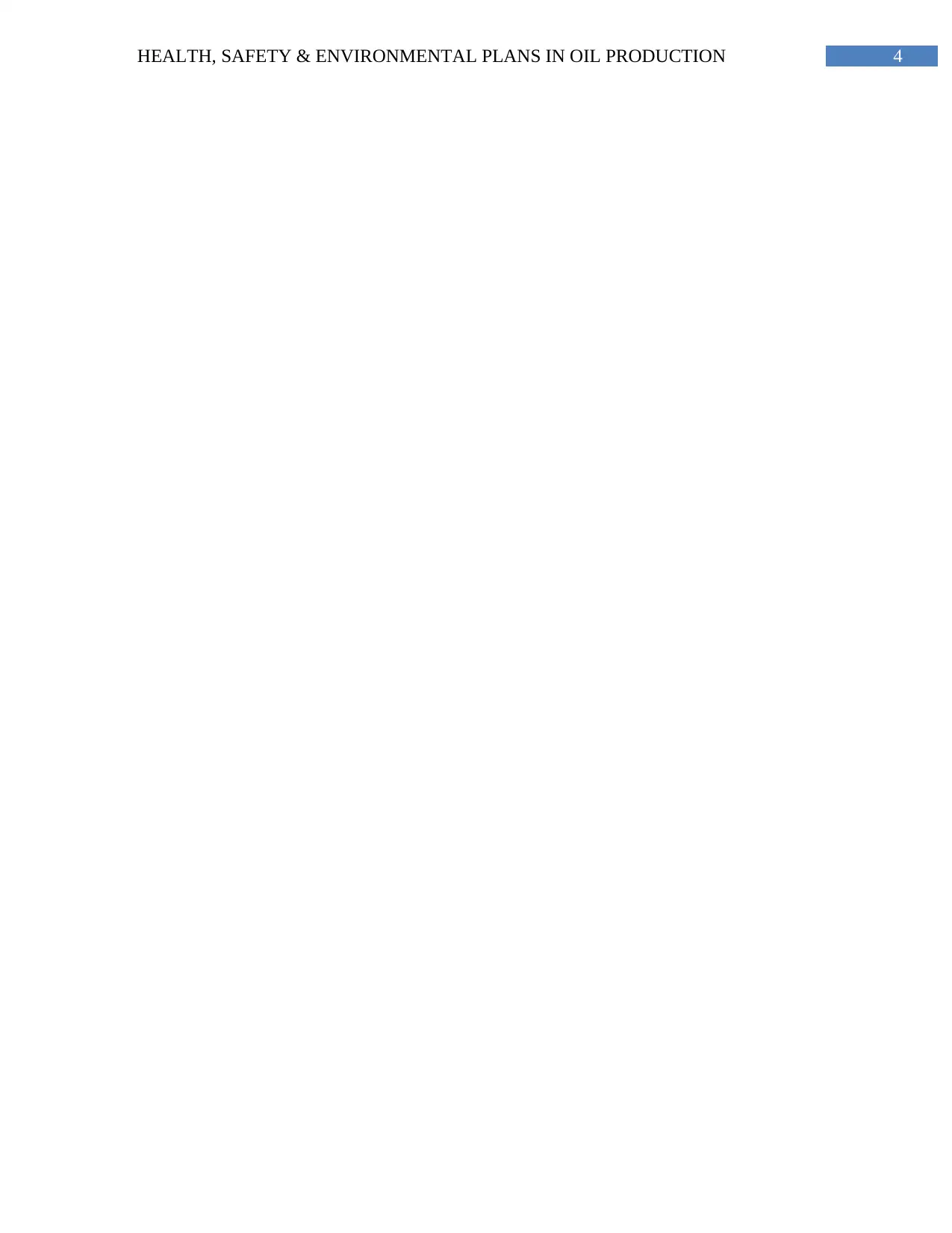
4HEALTH, SAFETY & ENVIRONMENTAL PLANS IN OIL PRODUCTION
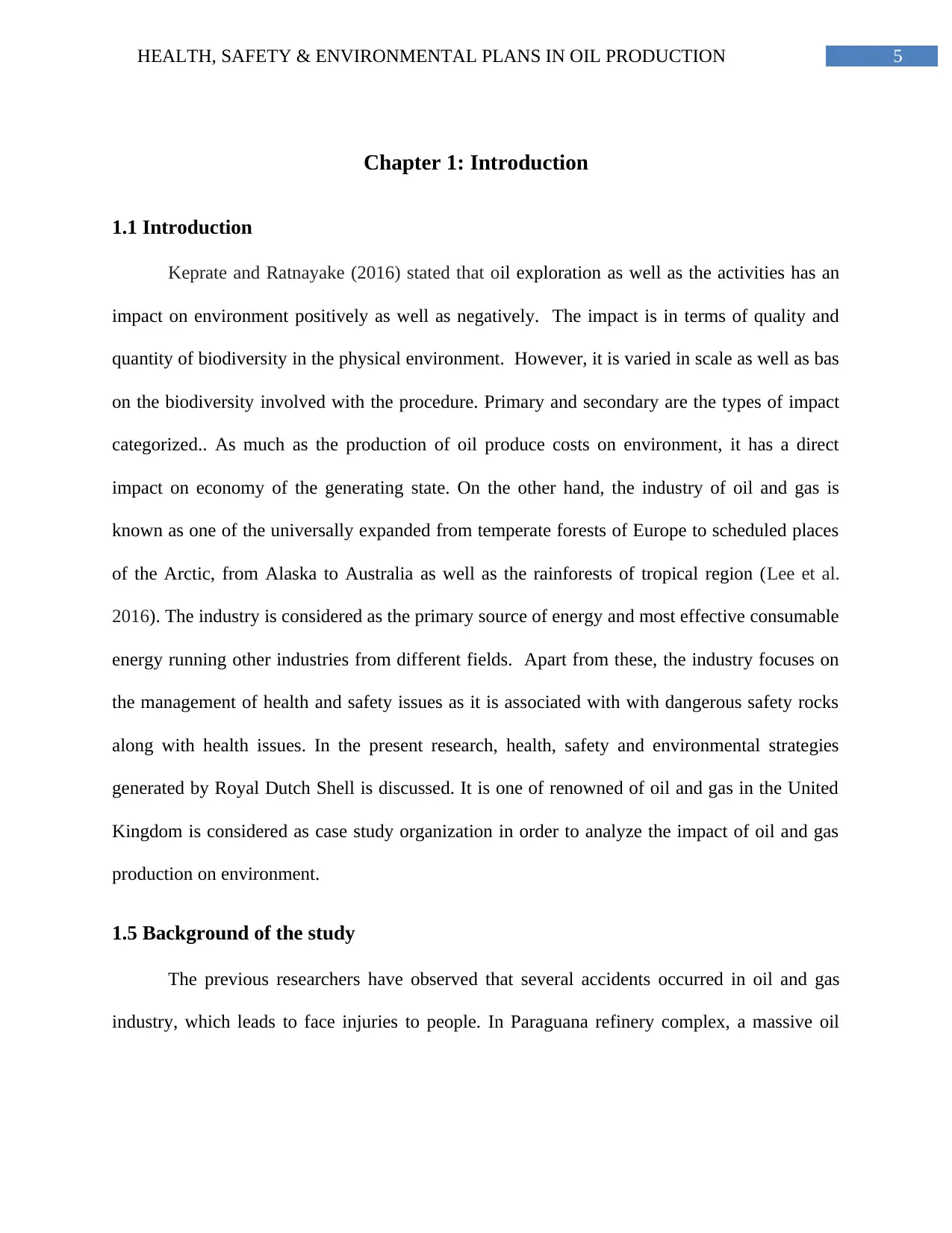
5HEALTH, SAFETY & ENVIRONMENTAL PLANS IN OIL PRODUCTION
Chapter 1: Introduction
1.1 Introduction
Keprate and Ratnayake (2016) stated that oil exploration as well as the activities has an
impact on environment positively as well as negatively. The impact is in terms of quality and
quantity of biodiversity in the physical environment. However, it is varied in scale as well as bas
on the biodiversity involved with the procedure. Primary and secondary are the types of impact
categorized.. As much as the production of oil produce costs on environment, it has a direct
impact on economy of the generating state. On the other hand, the industry of oil and gas is
known as one of the universally expanded from temperate forests of Europe to scheduled places
of the Arctic, from Alaska to Australia as well as the rainforests of tropical region (Lee et al.
2016). The industry is considered as the primary source of energy and most effective consumable
energy running other industries from different fields. Apart from these, the industry focuses on
the management of health and safety issues as it is associated with with dangerous safety rocks
along with health issues. In the present research, health, safety and environmental strategies
generated by Royal Dutch Shell is discussed. It is one of renowned of oil and gas in the United
Kingdom is considered as case study organization in order to analyze the impact of oil and gas
production on environment.
1.5 Background of the study
The previous researchers have observed that several accidents occurred in oil and gas
industry, which leads to face injuries to people. In Paraguana refinery complex, a massive oil
Chapter 1: Introduction
1.1 Introduction
Keprate and Ratnayake (2016) stated that oil exploration as well as the activities has an
impact on environment positively as well as negatively. The impact is in terms of quality and
quantity of biodiversity in the physical environment. However, it is varied in scale as well as bas
on the biodiversity involved with the procedure. Primary and secondary are the types of impact
categorized.. As much as the production of oil produce costs on environment, it has a direct
impact on economy of the generating state. On the other hand, the industry of oil and gas is
known as one of the universally expanded from temperate forests of Europe to scheduled places
of the Arctic, from Alaska to Australia as well as the rainforests of tropical region (Lee et al.
2016). The industry is considered as the primary source of energy and most effective consumable
energy running other industries from different fields. Apart from these, the industry focuses on
the management of health and safety issues as it is associated with with dangerous safety rocks
along with health issues. In the present research, health, safety and environmental strategies
generated by Royal Dutch Shell is discussed. It is one of renowned of oil and gas in the United
Kingdom is considered as case study organization in order to analyze the impact of oil and gas
production on environment.
1.5 Background of the study
The previous researchers have observed that several accidents occurred in oil and gas
industry, which leads to face injuries to people. In Paraguana refinery complex, a massive oil
⊘ This is a preview!⊘
Do you want full access?
Subscribe today to unlock all pages.

Trusted by 1+ million students worldwide
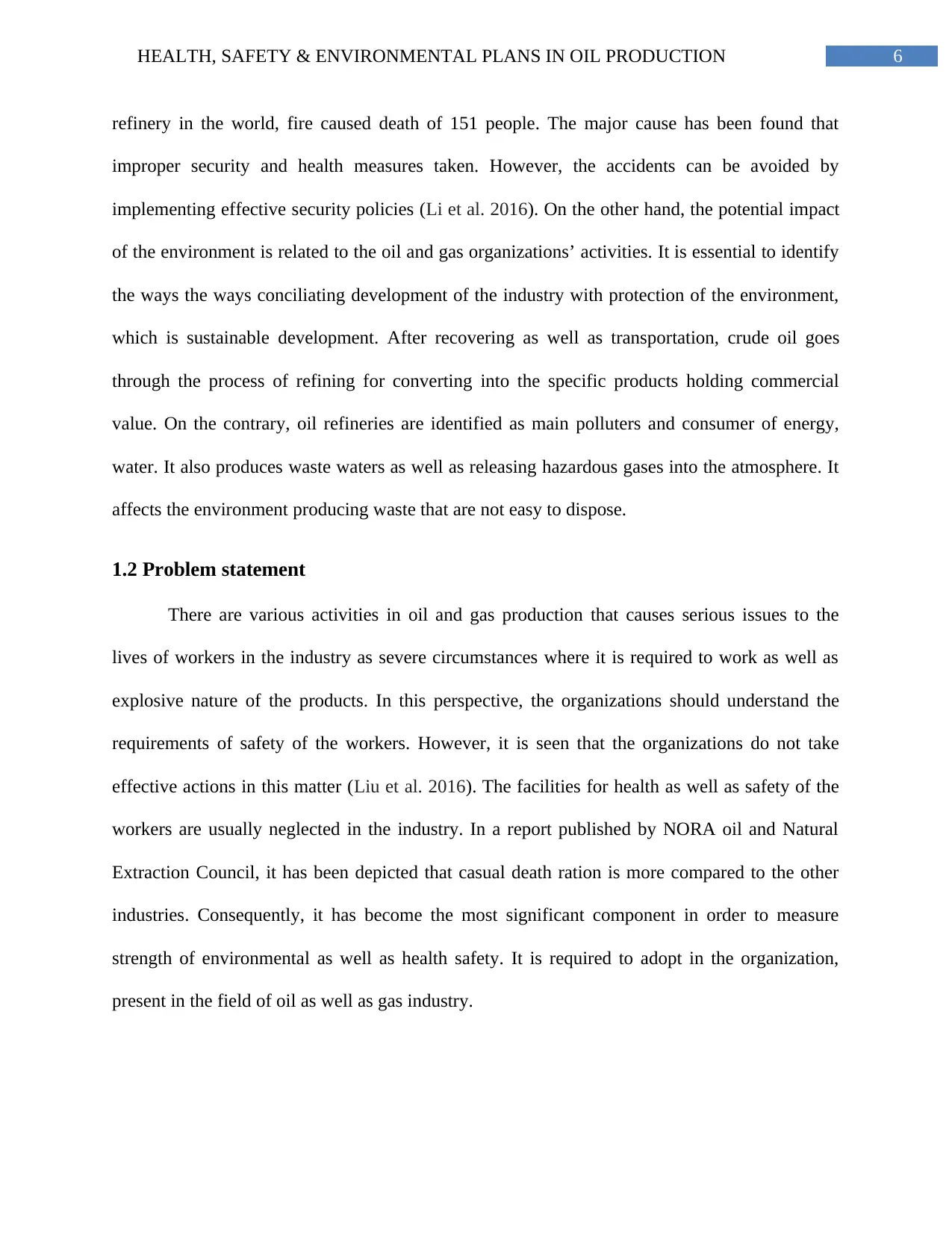
6HEALTH, SAFETY & ENVIRONMENTAL PLANS IN OIL PRODUCTION
refinery in the world, fire caused death of 151 people. The major cause has been found that
improper security and health measures taken. However, the accidents can be avoided by
implementing effective security policies (Li et al. 2016). On the other hand, the potential impact
of the environment is related to the oil and gas organizations’ activities. It is essential to identify
the ways the ways conciliating development of the industry with protection of the environment,
which is sustainable development. After recovering as well as transportation, crude oil goes
through the process of refining for converting into the specific products holding commercial
value. On the contrary, oil refineries are identified as main polluters and consumer of energy,
water. It also produces waste waters as well as releasing hazardous gases into the atmosphere. It
affects the environment producing waste that are not easy to dispose.
1.2 Problem statement
There are various activities in oil and gas production that causes serious issues to the
lives of workers in the industry as severe circumstances where it is required to work as well as
explosive nature of the products. In this perspective, the organizations should understand the
requirements of safety of the workers. However, it is seen that the organizations do not take
effective actions in this matter (Liu et al. 2016). The facilities for health as well as safety of the
workers are usually neglected in the industry. In a report published by NORA oil and Natural
Extraction Council, it has been depicted that casual death ration is more compared to the other
industries. Consequently, it has become the most significant component in order to measure
strength of environmental as well as health safety. It is required to adopt in the organization,
present in the field of oil as well as gas industry.
refinery in the world, fire caused death of 151 people. The major cause has been found that
improper security and health measures taken. However, the accidents can be avoided by
implementing effective security policies (Li et al. 2016). On the other hand, the potential impact
of the environment is related to the oil and gas organizations’ activities. It is essential to identify
the ways the ways conciliating development of the industry with protection of the environment,
which is sustainable development. After recovering as well as transportation, crude oil goes
through the process of refining for converting into the specific products holding commercial
value. On the contrary, oil refineries are identified as main polluters and consumer of energy,
water. It also produces waste waters as well as releasing hazardous gases into the atmosphere. It
affects the environment producing waste that are not easy to dispose.
1.2 Problem statement
There are various activities in oil and gas production that causes serious issues to the
lives of workers in the industry as severe circumstances where it is required to work as well as
explosive nature of the products. In this perspective, the organizations should understand the
requirements of safety of the workers. However, it is seen that the organizations do not take
effective actions in this matter (Liu et al. 2016). The facilities for health as well as safety of the
workers are usually neglected in the industry. In a report published by NORA oil and Natural
Extraction Council, it has been depicted that casual death ration is more compared to the other
industries. Consequently, it has become the most significant component in order to measure
strength of environmental as well as health safety. It is required to adopt in the organization,
present in the field of oil as well as gas industry.
Paraphrase This Document
Need a fresh take? Get an instant paraphrase of this document with our AI Paraphraser
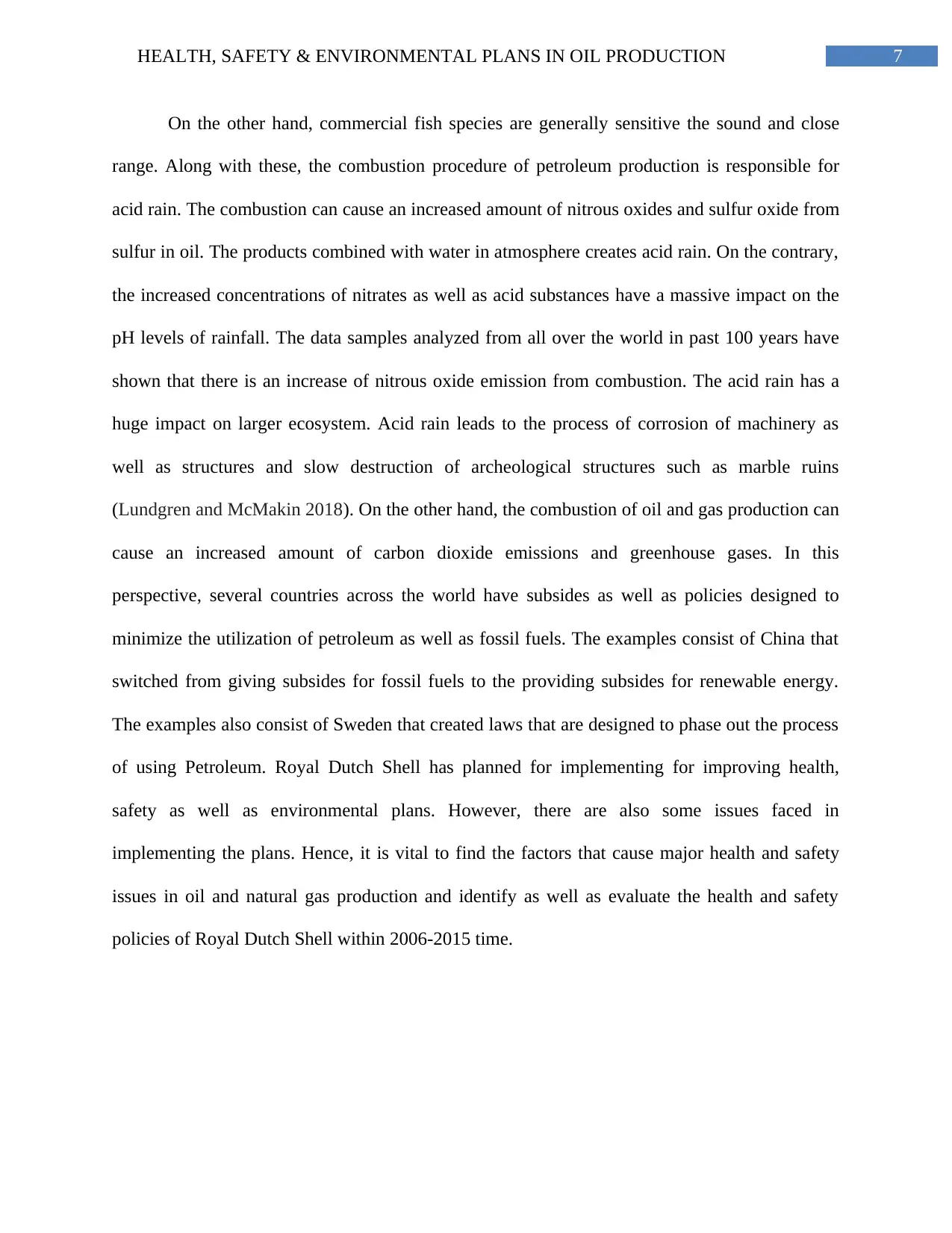
7HEALTH, SAFETY & ENVIRONMENTAL PLANS IN OIL PRODUCTION
On the other hand, commercial fish species are generally sensitive the sound and close
range. Along with these, the combustion procedure of petroleum production is responsible for
acid rain. The combustion can cause an increased amount of nitrous oxides and sulfur oxide from
sulfur in oil. The products combined with water in atmosphere creates acid rain. On the contrary,
the increased concentrations of nitrates as well as acid substances have a massive impact on the
pH levels of rainfall. The data samples analyzed from all over the world in past 100 years have
shown that there is an increase of nitrous oxide emission from combustion. The acid rain has a
huge impact on larger ecosystem. Acid rain leads to the process of corrosion of machinery as
well as structures and slow destruction of archeological structures such as marble ruins
(Lundgren and McMakin 2018). On the other hand, the combustion of oil and gas production can
cause an increased amount of carbon dioxide emissions and greenhouse gases. In this
perspective, several countries across the world have subsides as well as policies designed to
minimize the utilization of petroleum as well as fossil fuels. The examples consist of China that
switched from giving subsides for fossil fuels to the providing subsides for renewable energy.
The examples also consist of Sweden that created laws that are designed to phase out the process
of using Petroleum. Royal Dutch Shell has planned for implementing for improving health,
safety as well as environmental plans. However, there are also some issues faced in
implementing the plans. Hence, it is vital to find the factors that cause major health and safety
issues in oil and natural gas production and identify as well as evaluate the health and safety
policies of Royal Dutch Shell within 2006-2015 time.
On the other hand, commercial fish species are generally sensitive the sound and close
range. Along with these, the combustion procedure of petroleum production is responsible for
acid rain. The combustion can cause an increased amount of nitrous oxides and sulfur oxide from
sulfur in oil. The products combined with water in atmosphere creates acid rain. On the contrary,
the increased concentrations of nitrates as well as acid substances have a massive impact on the
pH levels of rainfall. The data samples analyzed from all over the world in past 100 years have
shown that there is an increase of nitrous oxide emission from combustion. The acid rain has a
huge impact on larger ecosystem. Acid rain leads to the process of corrosion of machinery as
well as structures and slow destruction of archeological structures such as marble ruins
(Lundgren and McMakin 2018). On the other hand, the combustion of oil and gas production can
cause an increased amount of carbon dioxide emissions and greenhouse gases. In this
perspective, several countries across the world have subsides as well as policies designed to
minimize the utilization of petroleum as well as fossil fuels. The examples consist of China that
switched from giving subsides for fossil fuels to the providing subsides for renewable energy.
The examples also consist of Sweden that created laws that are designed to phase out the process
of using Petroleum. Royal Dutch Shell has planned for implementing for improving health,
safety as well as environmental plans. However, there are also some issues faced in
implementing the plans. Hence, it is vital to find the factors that cause major health and safety
issues in oil and natural gas production and identify as well as evaluate the health and safety
policies of Royal Dutch Shell within 2006-2015 time.
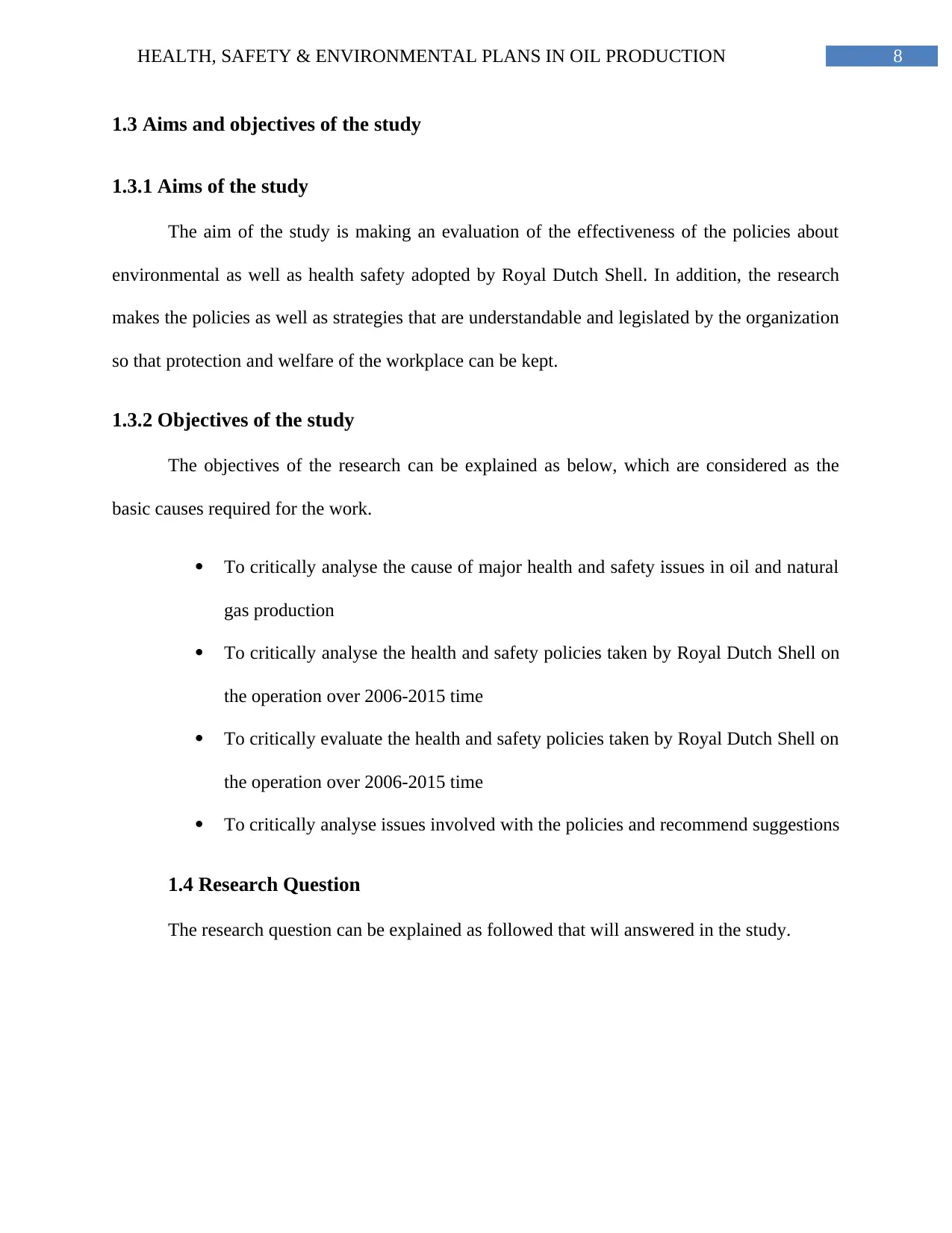
8HEALTH, SAFETY & ENVIRONMENTAL PLANS IN OIL PRODUCTION
1.3 Aims and objectives of the study
1.3.1 Aims of the study
The aim of the study is making an evaluation of the effectiveness of the policies about
environmental as well as health safety adopted by Royal Dutch Shell. In addition, the research
makes the policies as well as strategies that are understandable and legislated by the organization
so that protection and welfare of the workplace can be kept.
1.3.2 Objectives of the study
The objectives of the research can be explained as below, which are considered as the
basic causes required for the work.
To critically analyse the cause of major health and safety issues in oil and natural
gas production
To critically analyse the health and safety policies taken by Royal Dutch Shell on
the operation over 2006-2015 time
To critically evaluate the health and safety policies taken by Royal Dutch Shell on
the operation over 2006-2015 time
To critically analyse issues involved with the policies and recommend suggestions
1.4 Research Question
The research question can be explained as followed that will answered in the study.
1.3 Aims and objectives of the study
1.3.1 Aims of the study
The aim of the study is making an evaluation of the effectiveness of the policies about
environmental as well as health safety adopted by Royal Dutch Shell. In addition, the research
makes the policies as well as strategies that are understandable and legislated by the organization
so that protection and welfare of the workplace can be kept.
1.3.2 Objectives of the study
The objectives of the research can be explained as below, which are considered as the
basic causes required for the work.
To critically analyse the cause of major health and safety issues in oil and natural
gas production
To critically analyse the health and safety policies taken by Royal Dutch Shell on
the operation over 2006-2015 time
To critically evaluate the health and safety policies taken by Royal Dutch Shell on
the operation over 2006-2015 time
To critically analyse issues involved with the policies and recommend suggestions
1.4 Research Question
The research question can be explained as followed that will answered in the study.
⊘ This is a preview!⊘
Do you want full access?
Subscribe today to unlock all pages.

Trusted by 1+ million students worldwide
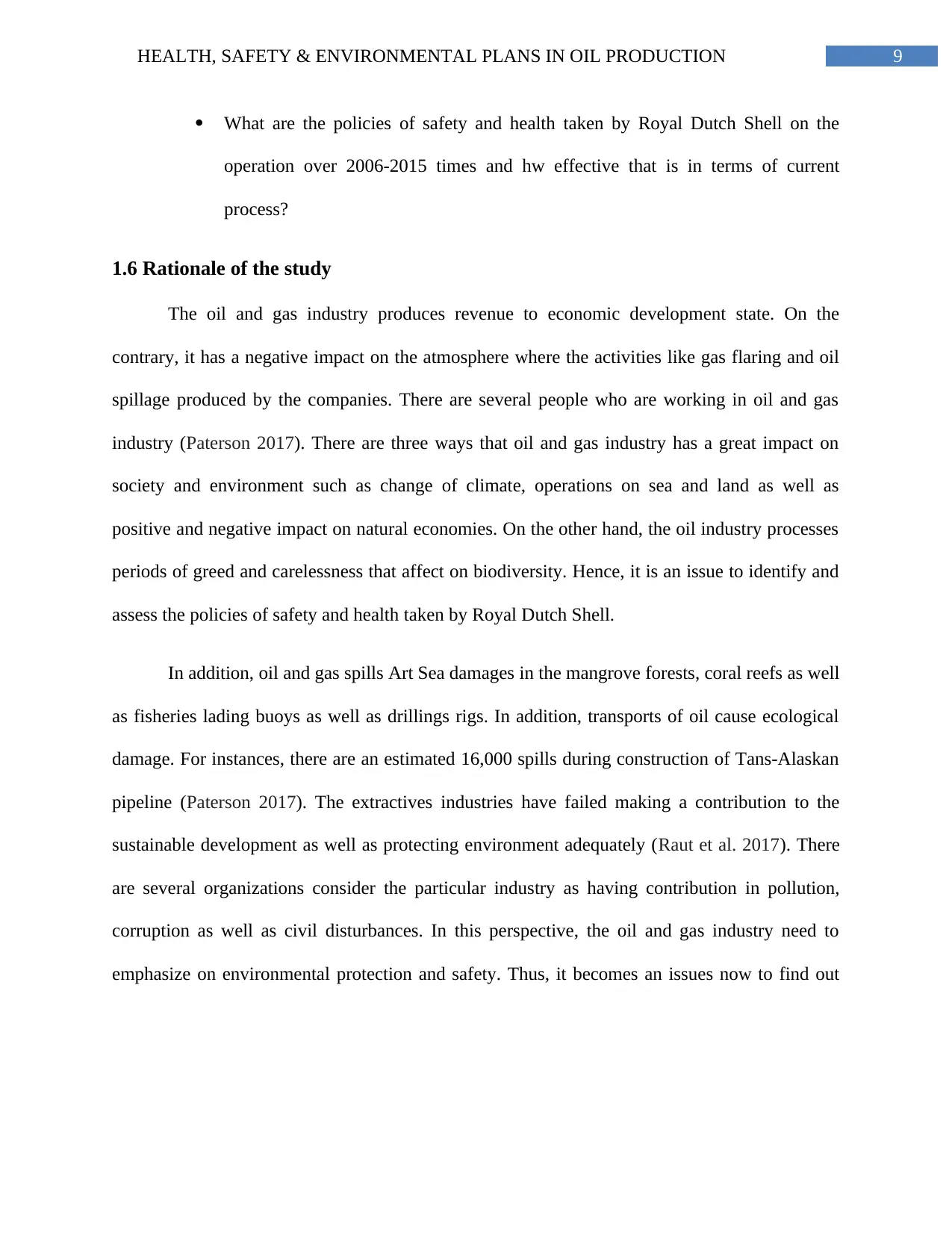
9HEALTH, SAFETY & ENVIRONMENTAL PLANS IN OIL PRODUCTION
What are the policies of safety and health taken by Royal Dutch Shell on the
operation over 2006-2015 times and hw effective that is in terms of current
process?
1.6 Rationale of the study
The oil and gas industry produces revenue to economic development state. On the
contrary, it has a negative impact on the atmosphere where the activities like gas flaring and oil
spillage produced by the companies. There are several people who are working in oil and gas
industry (Paterson 2017). There are three ways that oil and gas industry has a great impact on
society and environment such as change of climate, operations on sea and land as well as
positive and negative impact on natural economies. On the other hand, the oil industry processes
periods of greed and carelessness that affect on biodiversity. Hence, it is an issue to identify and
assess the policies of safety and health taken by Royal Dutch Shell.
In addition, oil and gas spills Art Sea damages in the mangrove forests, coral reefs as well
as fisheries lading buoys as well as drillings rigs. In addition, transports of oil cause ecological
damage. For instances, there are an estimated 16,000 spills during construction of Tans-Alaskan
pipeline (Paterson 2017). The extractives industries have failed making a contribution to the
sustainable development as well as protecting environment adequately (Raut et al. 2017). There
are several organizations consider the particular industry as having contribution in pollution,
corruption as well as civil disturbances. In this perspective, the oil and gas industry need to
emphasize on environmental protection and safety. Thus, it becomes an issues now to find out
What are the policies of safety and health taken by Royal Dutch Shell on the
operation over 2006-2015 times and hw effective that is in terms of current
process?
1.6 Rationale of the study
The oil and gas industry produces revenue to economic development state. On the
contrary, it has a negative impact on the atmosphere where the activities like gas flaring and oil
spillage produced by the companies. There are several people who are working in oil and gas
industry (Paterson 2017). There are three ways that oil and gas industry has a great impact on
society and environment such as change of climate, operations on sea and land as well as
positive and negative impact on natural economies. On the other hand, the oil industry processes
periods of greed and carelessness that affect on biodiversity. Hence, it is an issue to identify and
assess the policies of safety and health taken by Royal Dutch Shell.
In addition, oil and gas spills Art Sea damages in the mangrove forests, coral reefs as well
as fisheries lading buoys as well as drillings rigs. In addition, transports of oil cause ecological
damage. For instances, there are an estimated 16,000 spills during construction of Tans-Alaskan
pipeline (Paterson 2017). The extractives industries have failed making a contribution to the
sustainable development as well as protecting environment adequately (Raut et al. 2017). There
are several organizations consider the particular industry as having contribution in pollution,
corruption as well as civil disturbances. In this perspective, the oil and gas industry need to
emphasize on environmental protection and safety. Thus, it becomes an issues now to find out
Paraphrase This Document
Need a fresh take? Get an instant paraphrase of this document with our AI Paraphraser
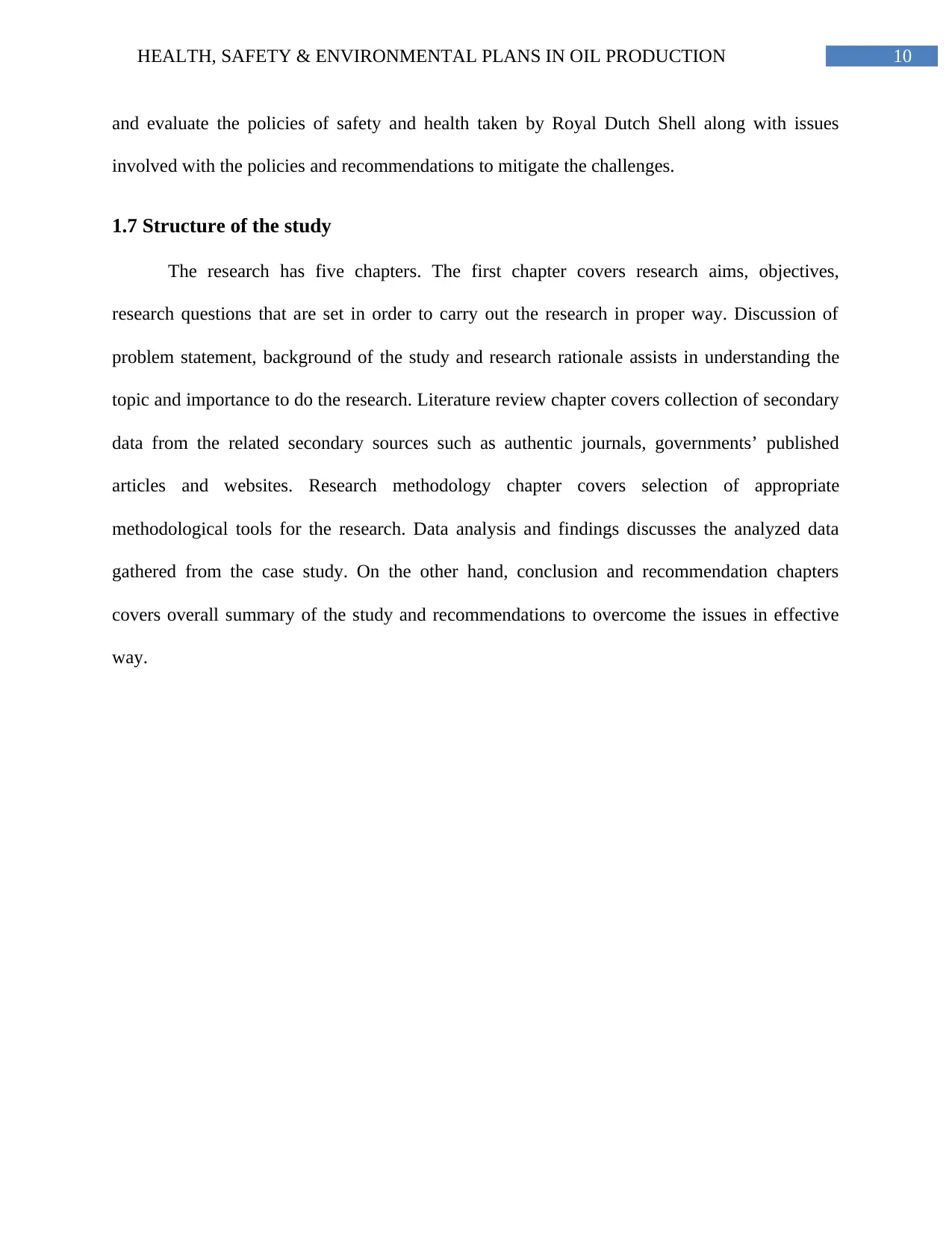
10HEALTH, SAFETY & ENVIRONMENTAL PLANS IN OIL PRODUCTION
and evaluate the policies of safety and health taken by Royal Dutch Shell along with issues
involved with the policies and recommendations to mitigate the challenges.
1.7 Structure of the study
The research has five chapters. The first chapter covers research aims, objectives,
research questions that are set in order to carry out the research in proper way. Discussion of
problem statement, background of the study and research rationale assists in understanding the
topic and importance to do the research. Literature review chapter covers collection of secondary
data from the related secondary sources such as authentic journals, governments’ published
articles and websites. Research methodology chapter covers selection of appropriate
methodological tools for the research. Data analysis and findings discusses the analyzed data
gathered from the case study. On the other hand, conclusion and recommendation chapters
covers overall summary of the study and recommendations to overcome the issues in effective
way.
and evaluate the policies of safety and health taken by Royal Dutch Shell along with issues
involved with the policies and recommendations to mitigate the challenges.
1.7 Structure of the study
The research has five chapters. The first chapter covers research aims, objectives,
research questions that are set in order to carry out the research in proper way. Discussion of
problem statement, background of the study and research rationale assists in understanding the
topic and importance to do the research. Literature review chapter covers collection of secondary
data from the related secondary sources such as authentic journals, governments’ published
articles and websites. Research methodology chapter covers selection of appropriate
methodological tools for the research. Data analysis and findings discusses the analyzed data
gathered from the case study. On the other hand, conclusion and recommendation chapters
covers overall summary of the study and recommendations to overcome the issues in effective
way.
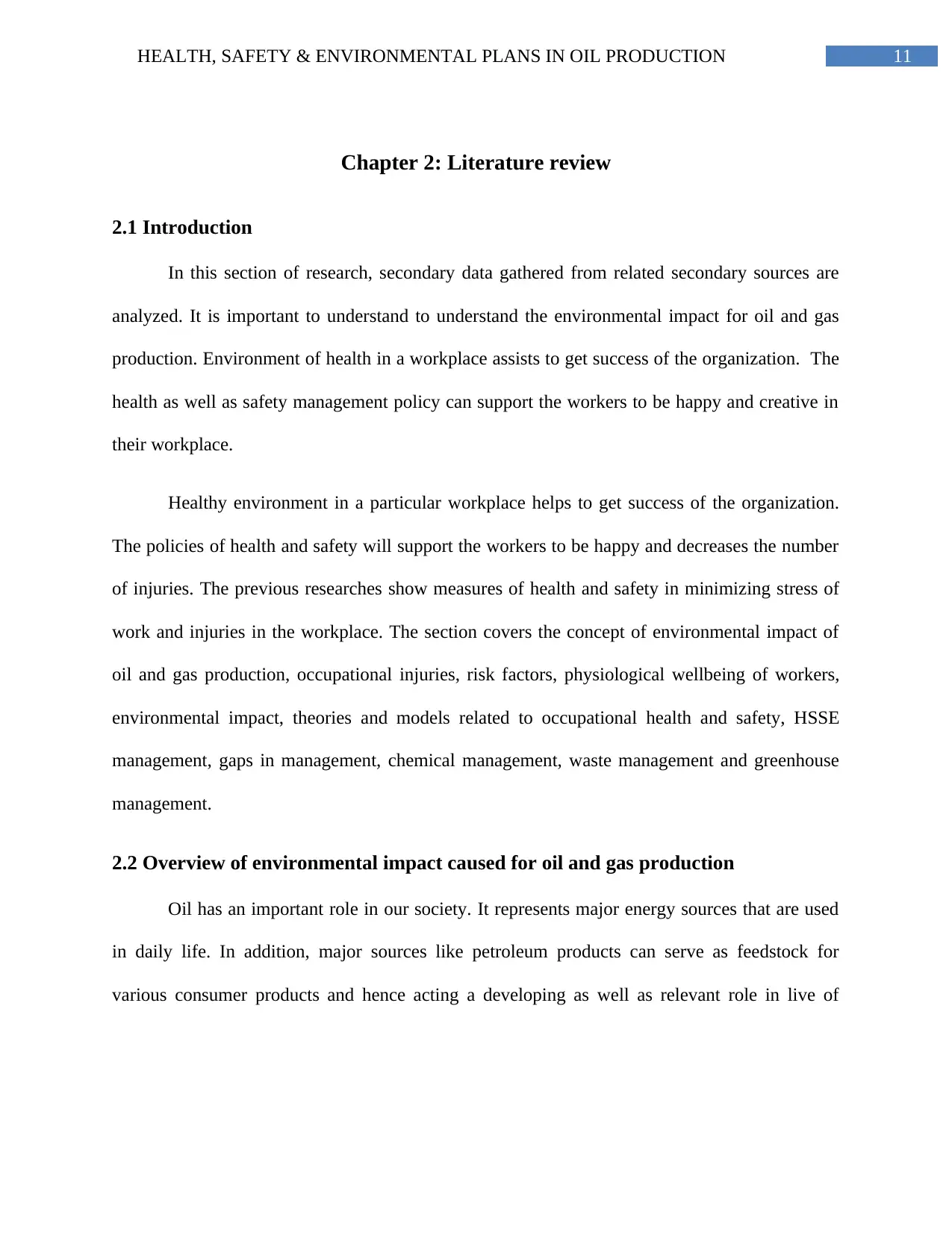
11HEALTH, SAFETY & ENVIRONMENTAL PLANS IN OIL PRODUCTION
Chapter 2: Literature review
2.1 Introduction
In this section of research, secondary data gathered from related secondary sources are
analyzed. It is important to understand to understand the environmental impact for oil and gas
production. Environment of health in a workplace assists to get success of the organization. The
health as well as safety management policy can support the workers to be happy and creative in
their workplace.
Healthy environment in a particular workplace helps to get success of the organization.
The policies of health and safety will support the workers to be happy and decreases the number
of injuries. The previous researches show measures of health and safety in minimizing stress of
work and injuries in the workplace. The section covers the concept of environmental impact of
oil and gas production, occupational injuries, risk factors, physiological wellbeing of workers,
environmental impact, theories and models related to occupational health and safety, HSSE
management, gaps in management, chemical management, waste management and greenhouse
management.
2.2 Overview of environmental impact caused for oil and gas production
Oil has an important role in our society. It represents major energy sources that are used
in daily life. In addition, major sources like petroleum products can serve as feedstock for
various consumer products and hence acting a developing as well as relevant role in live of
Chapter 2: Literature review
2.1 Introduction
In this section of research, secondary data gathered from related secondary sources are
analyzed. It is important to understand to understand the environmental impact for oil and gas
production. Environment of health in a workplace assists to get success of the organization. The
health as well as safety management policy can support the workers to be happy and creative in
their workplace.
Healthy environment in a particular workplace helps to get success of the organization.
The policies of health and safety will support the workers to be happy and decreases the number
of injuries. The previous researches show measures of health and safety in minimizing stress of
work and injuries in the workplace. The section covers the concept of environmental impact of
oil and gas production, occupational injuries, risk factors, physiological wellbeing of workers,
environmental impact, theories and models related to occupational health and safety, HSSE
management, gaps in management, chemical management, waste management and greenhouse
management.
2.2 Overview of environmental impact caused for oil and gas production
Oil has an important role in our society. It represents major energy sources that are used
in daily life. In addition, major sources like petroleum products can serve as feedstock for
various consumer products and hence acting a developing as well as relevant role in live of
⊘ This is a preview!⊘
Do you want full access?
Subscribe today to unlock all pages.

Trusted by 1+ million students worldwide
1 out of 46
Related Documents
Your All-in-One AI-Powered Toolkit for Academic Success.
+13062052269
info@desklib.com
Available 24*7 on WhatsApp / Email
![[object Object]](/_next/static/media/star-bottom.7253800d.svg)
Unlock your academic potential
Copyright © 2020–2025 A2Z Services. All Rights Reserved. Developed and managed by ZUCOL.





